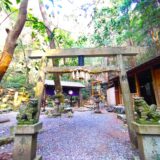【Kumano Hongu Taisha Otorii summary】
Kumano Hongu Taisha Oyunohara is part of the UNESCO World Heritage Site “Sacred Sites and Pilgrimage Routes in the Kii Mountain Range”. It is the former location of Kumano Hongu Taisha Shrine. It used to be lined with large multiple shrine buildings like Izumo-taisha, but most of the buildings were swept away by flooding during the Great Totsukawa Flood of 1889. This led to the relocation of Kumano Hongu to its current location. Today, the 33-meter-high Otorii gate, which was rebuilt in concrete in 2000, remains, as well as the approach to the shrine and the plaza where the shrine pavilions once stood.
![Kumano Hongu Taisha Otorii [Wakayama] DSC 0519 1024x790 - Kumano Hongu Taisha Otorii [Wakayama]](https://japan-shrine.info/wp-content/uploads/DSC_0519-1024x790.jpg)
The new Kumano Hongu Taisha shrine is within walking distance, and although you should probably visit the Taisha first and then explore here, you will want to see it first.
【Kumano Hongu Taisha Otorii scenery】
![Kumano Hongu Taisha Otorii [Wakayama] 26294916 m 1024x683 - Kumano Hongu Taisha Otorii [Wakayama]](https://japan-shrine.info/wp-content/uploads/26294916_m-1024x683.jpg)
The first-time visitor may be surprised to see it because it suddenly appears in the middle of rice paddies, but it is wonderful that the huge torii gate does not make you feel uncomfortable while being surrounded by nature. The scenery shown in each season is all good: cherry blossoms in spring, bright green rice fields in summer, and ears of rice in autumn. The scenery reminded me of the old days when people prayed to the shrine for a good harvest every year and received the bounty of nature.
![Kumano Hongu Taisha Otorii [Wakayama] DSC 0518 1024x661 - Kumano Hongu Taisha Otorii [Wakayama]](https://japan-shrine.info/wp-content/uploads/DSC_0518-1024x661.jpg)
It is big from afar, but when seen from close up, it is very powerful. The Yatagarasu shines in the center and looks cool.
![Kumano Hongu Taisha Otorii [Wakayama] DSC 0520 1024x768 - Kumano Hongu Taisha Otorii [Wakayama]](https://japan-shrine.info/wp-content/uploads/DSC_0520-1024x768.jpg)
The large Otorii (Grand Gate) is overwhelmingly large, and as you enter the shrine grounds, you will see a row of cedar trees that remind you of the history of the shrine. After passing through the approach to the shrine, you will find the remains of the old shrine building, but photography is prohibited. Please see for yourself. Except for the upper four shrines, which were moved to the present Kumano Hongu Taisha, the stone shrines of the middle and lower four shrines, which were washed away by the flood, are enshrined together, and the stone shrines of the regent shrines are enshrined.
![Kumano Hongu Taisha Otorii [Wakayama] DSC 0527 1024x768 - Kumano Hongu Taisha Otorii [Wakayama]](https://japan-shrine.info/wp-content/uploads/DSC_0527-1024x768.jpg)
The magnificent view of the Kumano River is also wonderful. However, it is said that the Kumano River is so fierce that in 2011 (Heisei 23), when Typhoon No. 12 hit the Kii Peninsula, it flooded the houses along the national highway where the current Otorii gate is located. Kumano worship has reincarnation as one of its themes, and there seems to be an interpretation that this sandbar is regarded as Onna-yin, the source of life.
![Kumano Hongu Taisha Otorii [Wakayama] DSC 0523 2 1024x570 - Kumano Hongu Taisha Otorii [Wakayama]](https://japan-shrine.info/wp-content/uploads/DSC_0523_2-1024x570.jpg)
It is recommended that you visit the nearby Wakayama World Heritage Center to learn about the Kumano Kodo before touring the area.
![Kumano Hongu Taisha Otorii [Wakayama] DSC 0659 1 160x160 - Kumano Hongu Taisha Otorii [Wakayama]](https://japan-shrine.info/wp-content/uploads/DSC_0659-1-160x160.jpg) Oomiwa Shrine [Nara]
Oomiwa Shrine [Nara]
Incidentally, the second largest torii in Japan is the one at Ojin Shrine in Nara Prefecture.
【Kumano Hongu Taisha Otorii Access】
Manager’s Comments
The torii gate, so large that you lose a sense of distance from it, was a sight to behold. I think it is best to visit during the cherry blossom season, the water mirror season when the rice paddies are filled with water, and the season of autumn leaves. Although there is nothing around the Otorii, I think it still attracts many worshippers as a place where one can feel close to God.
 Tour of Japanese shrines and temples
Tour of Japanese shrines and temples 

![Kumano Hongu Taisha Otorii [Wakayama] DSC 0544 520x300 - Kumano Hongu Taisha Otorii [Wakayama]](https://japan-shrine.info/wp-content/uploads/DSC_0544-520x300.jpg)
![Kumano Hongu Taisha Otorii [Wakayama] DSC 0544 150x150 - Kumano Hongu Taisha Otorii [Wakayama]](https://japan-shrine.info/wp-content/uploads/DSC_0544-150x150.jpg)
![Kumano Hongu Taisha Otorii [Wakayama] DSC 0463 150x150 - Kumano Hongu Taisha Otorii [Wakayama]](https://japan-shrine.info/wp-content/uploads/DSC_0463-150x150.jpg)
![Kumano Hongu Taisha Otorii [Wakayama] kumanonachitaisha1 150x150 - Kumano Hongu Taisha Otorii [Wakayama]](https://japan-shrine.info/wp-content/uploads/kumanonachitaisha1-150x150.jpg)
![Kumano Hongu Taisha Otorii [Wakayama] kumano hongu taisha oosaihara otorii jp1 150x150 - Kumano Hongu Taisha Otorii [Wakayama]](https://japan-shrine.info/wp-content/uploads/kumano-hongu-taisha-oosaihara-otorii-jp1-150x150.jpg)

